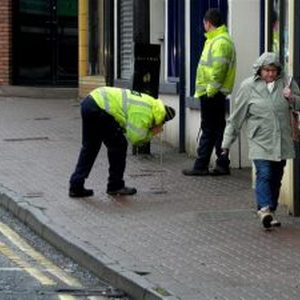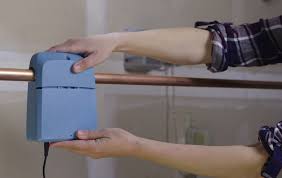Where Leaks Come From
Water leaks can happen for a lot of reasons. There’s a lot of hot, pressurized water shooting through your pipes every day. Even though your pipes are built to withstand it, over enough time, that water will begin to cut through or erode the walls and joints in your pipes; this same process is how canyons are formed.
Pipe Jointspipe joint leak
Most water leaks occur near or in a pipe joint, where one pipe connects to another. When water passes through joints on its way through the system, it gets shaken up as it is forced to swirl and squeeze to get from one pipe to the other. This little bit of extra turbulence makes the pipe walling around the joint wear down that much faster. Consequently, leaks are more likely the more bends, turns or elbows you have in your system.
Hard Waterhard water leak
The integrity of your pipes is also affected by the attributes of the water in your system. If your home has hard-water (mineral-heavy), it’ll eat through the pipe walls more quickly. Minerals are hard on pipes because they are coarse; as they move through the pipes, they scrape up against the inside, wearing it away. The pH value of your water will also affect corrosion. Water with subtly acidic properties will eat away at the lining of the pipe, weakening it and making it more susceptible to wear and damage.
Water Pressurewater pressure pipe leak
The more pressurized your water is, the faster it’ll shoot through your pipes. The higher the velocity of the water moving through the pipes, the rougher it’ll be on the inside of your pipes. Over time, the pipe will be worn away enough that tiny hairline fractures will be worn into them by the water. When water passes through the part of the pipe that’s worn away, the pressure of open water in the closed system will suck the water out causing leakage. If you think you might have a leak, don’t wait until it’s too late to contact a professional plumber.

How to Detect Leaks
Monitor the Water Bill
Monthly water bills are fairly predictable, so if you receive one that’s unusually high—and you haven’t been using excess water—you may have a leak. The Environmental Protection Agency suggests that a family of four will typically use no more than 12,000 gallons per month, except perhaps during the summer if you water a garden or lawn. Even small leaks, such as a faucet with a steady drip, can waste as much as 10,000 gallons of water per year, so keeping an eye on your water bill is a smart, proactive practice.
Watch the Water Meter
If you suspect a leak, monitoring your home’s water meter will give you a definitive answer. The meter is often located beneath a manhole-type cover near the street or (in areas where temperatures don’t dip below freezing) on the side or back of the house, near to where the water supply line enters the house. Follow these steps to monitor the meter:
- Turn off all water faucets in your home and make sure the washing machine and dishwasher are not running.
- Check the water meter and make a note of the numbers you see. Come back in an hour and check again. If the numbers have changed, there’s a leak somewhere.
- To determine if the water leak is in the house or outdoors (only for homes with meters located at the street), turn off the shut-off valve on your home’s main water supply pipe. This is either located in a basement or a utility room where the water pipe enters the home.
- Check the water meter, write down the numbers, and wait another hour. When you check again, if the numbers have not changed, the water leak is inside your home. If the numbers have changed, the leak is in the buried water line that runs to the house.
Check for Patches of Greener Grass
Everyone wants a lush lawn, but if an area in your yard is much greener (and grows faster) than the rest of the grass, it could indicate the spot where a buried water line is leaking. If the leak is profuse, you might even see some puddles on the surface of the ground.
Investigate Appliances and Fixtures
If the water meter test indicates a leak inside your home, check the cabinets under the kitchen, laundry, and bathroom sinks to make sure they’re dry. You’ll also want to look for puddles around the bases of tubs, toilets, and showers and beneath the water heater, dishwasher, and clothes washer. If you find any puddles, turn off the water supply valve to that appliance or fixture and call a plumber.

Leaking Faucets
Leaking faucets are generally a result of a worn rubber washer. The washer on a sink is usually located under the handle. These are relatively easy to replace, if you have the right tools. It does require shutting off the water under the sink or at the main shutoff valve and removing the handle. (Note: faucet handles are not shutoff valves.) Check your local home center or hardware store on how to repair faucet leaks.
Leaking Toilets
Toilet leaks can waste hundreds of gallons and often times are silent. Even a small leak can add up to a lot of wasted water and money over time. Fortunately, most toilet leaks are easy and inexpensive to repair.
To help determine if you have a leaking toilet, simply remove the tank lid and place a few drops of food coloring in back of the toilet tank. (If you don’t have food coloring, you can purchase dye tabs from any hardware or home center). Wait about 30 minutes, without flushing, and then look in the toilet bowl to see of any color has come through. If the water is clear, water is not leaking. If you see food coloring in the bowl you have a leak.
In most cases, you will simply just need to replace the toilet flapper and/or filling mechanism. These are available at hardware or home center stores for about $8.00 each.
Flapper Valve Leaks
The most common reason for a leaking toilet is one that has an improperly working or sealing flapper. The flapper is the rubber valve in the bottom of the tank that lifts up when the toilet is flushed. If the flapper is worn or cracked, it allows water to continuously flow from the tank into the toilet bowl without flushing.
Flush Handle Problems
If the handle needs to be jiggled to keep the toilet from running, the flush level bar and chain (or the handle itself) may be sticking. Adjust the nut that secures it in the toilet tank. If that does not work, the handle may have to be replaced.

Water Leak Detection Checklist
- The leak may be coming from your water mains supply, or there may be a mains water leak from your neighbour’s property. A leaking water main further up the road also could cause any leakage into your basement that you may be experiencing. You can contact your water supplier and get them to check your mains supply and your neighbours’ supply – the only neighbours that can really affect you are those either side of you or those on higher ground than you.
- If water has come through your walls or floor or into your basement you can get your water supplier to test it to determine where it’s come from – they will be able to tell you whether it’s ground water, mains water or sewage.
- You can test whether your foul water pipes have any leaks by blocking them up. Find out where your foul water drains away by turning a tap on and lifting up your manhole cover. You can block the hole the water flows from into the manhole with a bung available in either 4 inch or 6 inch sizes from your local builders’ merchants. Fill up your toilet bowl or sink with water and mark the level of the water. Leave the water overnight and see what happens – if the level of the water has dropped overnight then you need to get a drains company to come in to investigate and trace the leak in your pipes. You can find a qualified company to do this on the National Association of Drainage Contractors website. Alternatively, you may have a pretty good idea of where the leak is coming from at this point if you know where your wet area is, so you will know what needs to be mended. Make sure you remove the bung after completing the test!
- You can check whether the leak is coming from a fault in your surface drain by using a bag of drains testing dye that you can buy from your local builders’ merchants. Put the dye in the drain and then filling the drain up with water. This dye glows in the dark so you can then look at your leak at night and look for the dye to confirm that the water is coming from your surface drain.
- If the water is leaking in your bathroom or kitchen it’s a good idea to check your plumbed in appliances and bathtub/shower cubicle, sink and toilet.
- If the water is appearing in your floor you should check your central heating system as this may be the source of the leak – check your pipes and radiators, with your first check being the pipes that run under the area of damp floor. You can also ask a plumber in to do a pressure test as this may help to trace where in the system the leak is coming from if this is the source of the leak.
The Process Of Leak Location
Electronic leak detection devices locate and confirm leaks by listening to the sound of water running along the pipes, using a microphone. Your plumbing contractor will choose the best location to set up the electronic leak detection device. The sounds it records will then be transmitted to a computer program, where the plumber will analyze the information. An experienced licensed plumber will know whether the sound is from a cracked pipe or a leaking faucet. From there, they will determine the best repair technique appropriate to repair the leak.
Electronic leak detection is not only used to determine water leaks. It can also be used to locate leaks in other pressurized systems, like the compressor of an air conditioner or refrigerator, and in natural gas lines.
Concerned About Wall & Floor Damage?
Don’t be. Back in the day, a licensed plumber would need to rip open the wall or dig up your entire floor in order to find the location of a leak. Today, with electronic leak detection, wall and floor damage is minimal. Since the plumber determines the exact location of the leak beforehand, the part of the wall to be removed or the area of the floor that will be dug up will be smaller. A smaller hole also means bigger savings for you in terms of time and money.